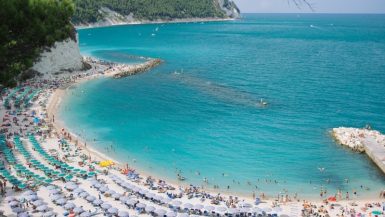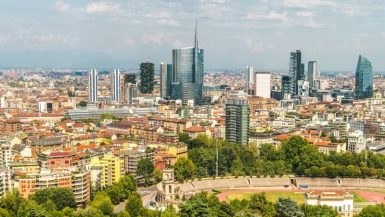
Italy is known for its glorious hot summers of bright sunshine and beautiful blue skies, but come winter some parts of the country get decidedly chilly. The north of Italy in particular sees temperatures drop during the winter months. As a result, all of the coldest places in Italy are to be found in the north of the country.
Italy’s northern regions are home to two of Europe’s most spectacular mountain ranges, sitting at the foot of the Alps and with the Dolomites cutting across the east. The rugged north of the country is not only the coldest part of Italy but also one of the most beautiful areas of Europe. Bordering a host of European countries, northern Italy is populated with gorgeous picture-box mountain towns and municipalities. During the winter, much of the region is blanketed in snow, and many of northern Italy’s towns and mountains are incredibly popular ski resorts.
Grab a cappuccino and wrap up in something warm as we take a whirlwind tour of some of the coldest places in Italy.
Busa Fradusta

Whilst it’s unlikely to feature in many people’s itineraries during a trip to Italy, Busa Fradusta certainly deserves its place on a list of the coldest places in Italy. At almost 3000 meters above sea level, Busa Fradusta is one of the main peaks of the Dolomite mountain range, making it a bit inaccessible for all but the most determined of travelers. Anyone wanting to hike up to the peak in winter is also going to need plenty of layers. Busa Fradusta is not only the site of the coldest temperature ever recorded in Italy, but it’s also the coldest place in southern and western Europe.
In February 2013 the temperature at Busa Fradusta dropped to a record low of -49.6 °C. Throughout Europe there have only ever been colder temperatures in Russia, Finland, Sweden, and Norway, four countries famously known for their cold climates. With such low temperatures it’s perhaps no surprise that a glacier descends from the northern side of the Busa Fradusta. The Busa Fradusta is part of a chain of mountains in the Dolomites known as the Pale di San Martino. In 2009 the Dolomites were granted UNESCO World Heritage status.
Livigno

While Busa Fradusta may take the title of the coldest place in Italy, it’s certainly more than a little remote. The town of Livigno in Lombardy, right next to the Swiss border, lays claim to having the coldest temperature ever recorded in an inhabited part of the country, where the temperature once plummeted to -37 °C. Right next to the Alps, Livigno is a mountain town that’s home to around 6,000 people, and at over 1,800 meters above sea level is thought to be one of the highest inhabited towns in all of Europe.
From November to April every year the town is typically constantly below freezing. Even in summer, it’s not uncommon for temperatures to fall below zero. On average Livigno sees 250 days a year where the temperature drops under 0 °C, making it one of the coldest places in Italy. Such cold weather means a lot of snow and Livigno is a hugely popular skiing spot. With over 100 kilometers of ski slopes and over six months of snow in the nearby mountains, there are few better places for skiing in Europe.
Aosta Valley

The Aosta Valley is a region found right in the northwest corner of Italy, wedged up against the borders of Switzerland and France. Like all of northern Italy, the Aosta Valley gets very cold in winter. Mont Blanc, the highest mountain in the Alps as well as Western Europe, straddles Italy and France, reaching into the Aosta Valley. The entire Aosta region is at least 1000 meters above sea level with large swathes of the Aosta Valley reaching as high as 3000 meters above sea level. The higher areas have the coldest temperatures, and the record low for the valley came in 1963 when the temperature dipped to -42 °C in the valley close to Mont Blanc.
Aosta Valley is the smallest of Italy’s twenty regions, and perhaps because of its mountainous terrain and cold climate it’s also the least densely populated. Much of the region is covered in snow for up to nine months of the year, though temperatures reach as high as 35 °C come the height of summer. This contrast between freezing winters and gloriously hot summers is a common factor in almost all of the coldest places in Italy. No matter how cold it gets in winter in Italy, come summer you’re almost guaranteed blazing sunshine and soaring temperatures.
Trentino

Trentino is another region of northern Italy buried beneath the Dolomites and the Alps and close to the border with both Austria and Switzerland. Along with much of the north of Italy, Trentino has been passed around between several old empires throughout its history, coming under Austrian, German and French control over the past 1000 years. Today, just under a third of the population speaks some form of local German dialect as a first language, rather than Italian.
Being this close to the Alps means that the temperatures in Trentino get pretty chilly in winter. The daily average low in the region’s historic capital city of Trento is little more than 1 °C during the height of winter. December and January also usually see somewhere between 14 to 19 centimeters of snowfall each year and temperatures have been known to drop as low as -15 °C. Unsurprisingly Trentino is a big tourist destination for lovers of winter sports, with plenty of options available for those who want to try skiing, snowboarding, and hiking.
Bolzano

Just a hop and a skip from Trentino is Bolzano, a small but beautiful alpine city located in the neighboring province of South Tyrol. Bolzano also enjoys very different weather patterns at either end of the year, and while the temperature during the summer soar as high as 30 °C, it’s a very different story in winter. By December and January the temperature in Bolzano dips to around -4 °C. In particularly cold winters the temperature can drop even further, with the record low for the city being a pretty chilly -18 °C.
As with much of northern Italy, the city of Bolzano sits high amongst the mountain ranges that pass through the region. The majority of the city is around 200 meters above sea level and sits in a natural basin surrounded by mountains. Ever since the medieval period the city has enjoyed a strategic location on many local trading routes and its history has played a huge part in shaping the city today. One of the most beautiful cities in the Alps, Bolzano is famous for its gorgeous blend of Italian and Austrian architecture, including its grand central square and the imposing Bolzano Cathedral that dates from the 12th century.
Sondrio

A few hours west of Bolzano is the equally historic and picturesque city of Sondrio. With its roots stretching back as far as the Holy Roman Empire in the Early Middle Ages, Sondrio has also changed hands several times, coming under French and Austrian control before finally becoming a part of Italy in the 19th century. The city of Sondrio is the capital of the region of the same name, and as with Trentino and Aosta Valley, this is one of the coldest places in Italy. The average annual temperature in Sondrio is just 4.2 °C, and in winter it’s not unusual for the mercury to drop as low as -10 °C.
As well as a major winter sports destination the winding mountain roads around Sondrio are a major draw for road cyclists during much warmer times of the year. Like much of the region of Lombardy, the area is also a major wine-producing region, with some of the best wines in Italy produced from grapes grown on the steep hillsides that surround the city.
Turin

Though Turin may not regularly experience the extremely low temperatures seen in areas further north, it is certainly the coldest of Italy’s major cities. The capital of the region of Piedmont and home to over two million people, Turin’s average annual temperature is 12 °C. In winter, though, the daily average often hovers around 2 °C, with the average low around -2 °C. The lowest temperature ever recorded in Turin was a pretty nasty -20 °C.
Turin is one of Italy’s oldest cities and has a very long history, dating back to around the 1st century BC. Today, Turin’s streets are lined with beautiful baroque architecture that leads to numerous stunning piazzas and a litany of striking museums and churches, including Turin Cathedral. Inside Turin Cathedral is the Chapel of the Holy Shroud, built specifically to display the famous Shroud of Turin. Turin Cathedral is connected to the Royal Palace, a UNESCO World Heritage site built as a palace that is now a museum. Turin is the perfect place for a city break, but remember to wrap up warm if you visit in winter.
Where is the coldest place in Italy?
The coldest place in Italy is Busa Fradusta, one of the peaks in the Dolomite mountain range. The coldest inhabited place in Italy is the town of Livigno, close to the border with Switzerland.
What is the coldest it has ever been in Italy?
The coldest temperature ever recorded in Italy was -49.6 °C at Busa Fradusta. This is also the coldest temperature ever recorded in southern Europe.
Does it ever snow in Italy?
Yes, it snows frequently in the north of Italy with the mountainous areas around the Alps often under snow for eight or nine months of the year.
What is the coldest month to visit Italy?
January is the coldest month in Italy. Winter will have truly settled in by December and is also cold but January is the height of winter in Italy.


